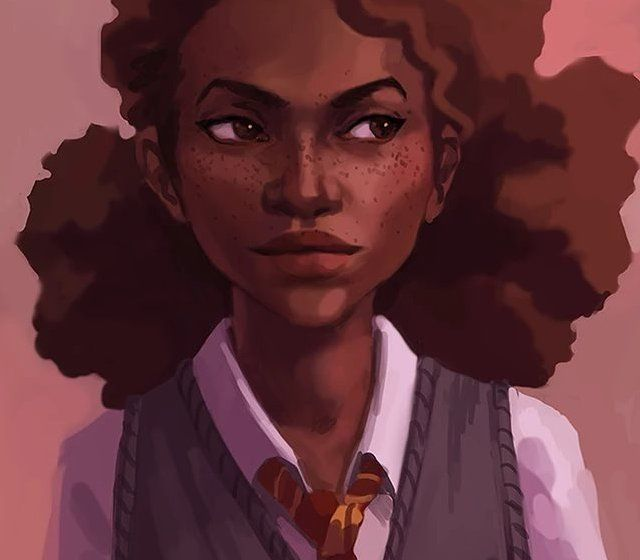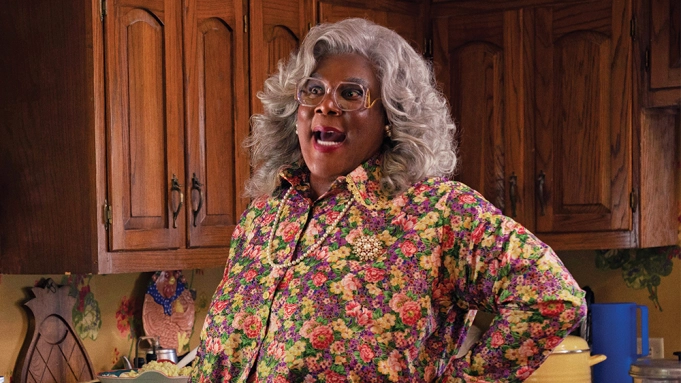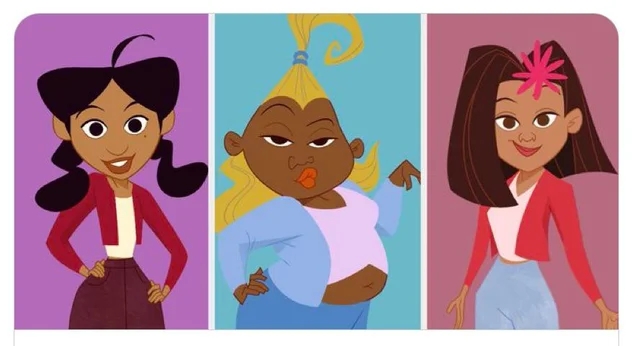
When the word “racism” and “race” is brought up, for most the first thing that pops into one’s head is the thought that it is a black-and-white issue, but why is that?
Personally, as a black woman it is hard not to recognize that the way I am first perceived is black before I am perceived as a woman and so for me, my race is the first thing that I think of when it comes to race. For many other black people, it’s a hard reality we have to face every day as it crosses over into every aspect of our lives, whether that be our career, safety, finances, etc, and so for us, it’s quick to think of the struggles we face. Additionally while researching I found that the deep-rooted racism in America and its history with slavery is what plays a huge role in the reason “racism and race” are predominantly perceived as a black-and-white problem.
Though this is true for many black people, especially in America, it makes me think, what about beyond that? Does our TV also play a role in how black people are perceived in society?
To tackle this issue I first break down the terms race and racism, and with a quick google search, I found that both originated in the 18th century as a way to justify slavery. With terms like “reverse racism” floating around it’s easy to forget the definition of the word and so it pushes forward the black-and-white narrative of race.

I then turned to the first representations of Black people in America which then brought me to the racist and negative portrayals of blacks that then formed the birth of stereotypes. The first portrayal of black people in the media was Black Face. The caricature, represented by non-black people wearing black paint on their faces, often paired with big red lips, was used to demean and mock those of the black community for entertainment purposes and it became popular during the Civil War Era.


Of course, we have moved beyond the nature of blackface… right?
When it comes to black representation although there are far less extreme depictions of blacks in the media there are still some very stereotypical depictions circulating in the media present day. Begginging with the first black actor Stepin Fetchit ,who is controversial to many for his role in racist depictions, but who also paved the way for so many great black actors. The interesting thing about him though is that he actually is of carribean descent but most refer to him as “African American”.

From him, onwards there would be many more black actors in Hollywood and more representation. We would go on to win many awards and start new shows, with, however, subtle racist and stereotypical depictions.
When it comes to present day depictions in the media I break it down into four categories: stereotypes, colorism, white washing, and tokenness (a term I use to describe a character that’s simply there to fill a quota).
When it comes to stereotyping most often depicted in black roles is the angry/sassy black woman, the black criminal thug, and the athlete/musician. This also sets the precedent for “acting black”.
The angry black woman is most often depicted as “ratchet” and “ghetto” who always has something to say or has a sassy comeback. Her mannerisms are often exaggerated, whether she is snapping her fingers or saying “mm girl”. These characters often play the role as the best friend and are cast as “undesirable”. A good example of this is “The Proud Family” and the character Dijonay. Down to the stereotypical black name and the portrayal of her being a dark-skinned black girl, she is exudes all the traits of a “ghetto, sassy black woman”. She’s a loud, aggressive, “hood” girl who constantly stabs Penny in the back and is a terrible best friend.

The black criminal thug. It is not uncommon to watch movies about gang violence featuring black males which has led to a predominantly black narrative in the world of crime. This dangerous narrative has led to the incarceration of many blacks as well as racial profiling and stigma against black communities. It is well known, the struggles we face in our communities due to the portrayal of a black man in baggy clothing holding a gun and engaging in dangerous activities like drug dealing and gang violence. Although this is a true tale for some who live in the poorer parts of the country, it is not the sole reality for many in this country. Overseas, this allows for people to associate blacks with that of being “hip and cool” and/or flashy and excessive. A movie that depicts this is “Baby Boy” a 2001 and one film that depicts the misguided life of a black teen in the hood. He is depicted as jobless, fatherless, and irresponsible, ultimately giving into the violence and killing another character.
The black musician/athletic character is not as bad as the other two depictions, however, is still stereotypical. Black people are more than just sports and music, although we have paved the way for both of those industries due to the lack of resources available. It’s dangerous to assume that that is all we are good for when there are a lot of black mathematicians, philosophers, business owners, etc., who fail to be depicted in the media. A common example is how often black people are associated with athleticism especially when it comes to the sports industry in relation to basketball and football. Truthfully, because of the lack of resources and wealth disparities in America, the most affordable sport to indulge in is Basketball and football because you can be self-trained and easily play at the park or at home. When it comes to music, we have our roots in the hip-hop scenery, but we also have our roots in jazz, rock, and roll, afro/any drum beat, however the one we are solely held to and depicted in is hip-hop and rap which then ties again into the stereotypical “hood” figure.


Coincidentally enough when searching for pictures for my slide, I encountered the following; which goes to show that we still haven’t moved on from the negative connotations of black people and crime. (Notice how I did not add black in the search bar) . Ironically enough when looking at the statistics, the real gangsters are much more dispersed than the black actors cast as gangsters.

Shifting a little away from stereotypes onto who is actually represented in the media, there is the factor of colorism which features light-skinned, dark-skinned, and brown-skinned people. The “pretty”, “handsome” or “desirable” character is often depicted as a light-skinned person. Often times they are also cast into black roles, and this includes those of mixed-race backgrounds. Dark and brown-skinned people are cast as undesirable one or unlikable characters. This allows for further division within the black community. Revisiting the show “The Proud Family”, the character Djonay is obnoxious and constantly backstabs Penny, while Penny is seen as beautiful, smart, and empathetic. Additionally, there are the depictions of “The Gross girls” who are bullies and portrayed as blue characters with more afro-centric features than the rest of the cast (even so exaggerated). It’s not too complex to figure out where I’m going with this.
Adding onto colorism, whitewashing is very common to see in the media. Looking at Harry Potter and Emma Watson being cast in the role of Hermione who was written as a black character. Strawberry Shortcake’s “Orange Blossom” got redesigned to be lighter and have less curly hair and more eurocentric-based features. Another depiction is Princess Tiana who already got so little spotlight in her own movie, depicted as a lighter-toned character with light brown hair and loose curls. This again strays to the beauty standards of white, European-based features.



(Orange Blossom’s redesign in Strawberry Shortcake)
Tackling the idea of tokennes in the media there has always been the idea of having a “black” best friend. Looking at films and cartoons like Clueless, High School Musical, Forrest Gump, and Kim Possible. Often times black people are depicted as side character that only exists to support the main role being a white person. This strips the identity of a black person and demeans them to that of a tool to use to achieve a goal. Studying into Dionne from Clueless who solely matched with Cher and supported her as her best friend in a predominantly white cast, with no spotlight on her, it is clear her sole purpose is to add diversity points to the film. It even worked as it drew a black audience to watch and indulge in the film.
(As of present day Dionne is now getting her own reboot so the focus will now shift to her)

With all these negative reprsentations there are some media that adhere to it and others that challenge it. “Pose” is one of the films I highly recommend as it explores black sexuality which is largley underrepresented in the media. This show challenges the stereotypical queer and black representation with its premise of the struggles of the BIPOC LGBTQ+ community in the 1980’s .

On the other hand films and shows like Tyler Perry’s franchise Madea, may be funny, however they enforce black sterotypes. The character “Madea” is the epitome of an angry, sassy, violent black woman who has been incarcerated on multiple ocassions. She does teach lessons and address racial problems from time to time but it’s hard to do so accurately when the character is built on these sterotypes. Additionally, within Tyler Perry’s main storylines, he often depcicts the angry black women and the violent dark skin husband and the light skin alternative man.

So how do we move past these barriers?
Well Denzel Washington and Kamau Bell both talk about their role as Black Men representing a black community. Denzel points toward the notion of having more black directors that goes beyond that of race, but adheres to culture for a better understanding of black representation.
Kamau Bell takes on his depicton of race as a director and how he has the hard discussions as well as portray this through camera lens on his show “United Shades of America” and more. (I encourage you to watch from 06:14)
Click this link to view my presentation. There are more layers to these issues and much more problematic issues of representation in the media, so I encourage you to visit these links as well as think about these questions:
- Have you encountered international media that stray away from or adhere to negative stereotypes?
- How do you see the portrayal of blacks in the media?
- Did you notice some common stereotypes in media that you have watched?
- What are some ways this media has negatively impacted society?
- Are these tropes still common in the media today? Have we moved passed this?



This media has negatively impacted society and young black boys and girls and gives the impression that being ‘white’ is the societal norm. So many black fictional characters in the media are incredibly whitewashed and can even be portrayed as caricatures who are loud, obnoxious, and “ghetto” which is entirely untrue. For young boys and girls growing up consuming media on a daily basis, it teaches them to think certain things about race in society and gives the impression that being a POC makes you a token character in shows and books. I learned so much in this presentation and I think you did a great job articulating and highlighting the problems with race in our society and how detrimental it can be for minority groups and especially black girls and boys who are being taught these things.
LikeLike
I have defintely noticed a bit of these instances that you have mentioned not only in TV, but in movies as you mention as well with “Clueless”. I happened to just finish watching “Akeelah and the Bee” (2006) starring Keke Palmer, Lawrence Fishburne, and Angela Bassett. It follows Akeelah Anderson, who is an 11-year old competing in the Scripps National Spelling Bee.
I did happen to notice a few tropes, but subtler than other films. For one, the “villanous” characters in the movie (Akeelah’s bullies at school, her brother who sneaks out) all are hairstyles associated to the Black community, as opposed to the characters (mainly the protagonists) who have “normalized” hairstyles. Addiitonally, Lawrence Fishburne’s character Dr. Joshua Larabee insists on not using slang and only “words that are in the dictionary” and not to use verancular or slang. When she proves to him that “dissing” is in the dictionary, he gets upset, but accept sthat fact nonetheless. Little things like that were what annoyed me about the movie, but I would highly recommedn it if you haven’t seen it.
Nevertheless, movies have come a ways since 2006, but I owuld not say they have come a long ways. Yes, while representation is increasing in the industry, there is still much to be desired to make everyone feel heard and respected within it.
LikeLike
Your presentation brings up important issues in our media. The one-dimensional or stereotypical portrayal of black characters in the media limits the audience from thinking about where black people exist in their world. Whether it’s a child who’s never seen themselves portrayed as the main character or a child that’s learned that their experience of the world is the only one. In media like high school musical, Good luck Charlie, and even the Vampire diaries, the black best friend is only there to support rather than have a life or goals of their own. It might seem like I’m dragging it because the side characters won’t have as much depth. However, their one-dimensional personalities are consistent throughout the media.
LikeLike